Abstract
The enzymatic carboxylation of phosphoenolpyruvate by cell-free extracts of Neisseria gonorrhoeae was examined and determined to be similar to the reaction catalyzed by phosphoenolpyruvate carboxylase (PEPC). This was shown by the irreversibility of the reaction and nucleotide independency. The enzyme was found to have some characteristics different from the other bacterial PEPCs reported. The enzyme showed catalytic activity in the presence of cobalt ions as well as magnesium and manganese ions, was not inhibited by succinate in fresh extracts, and displayed a low Michaelis constant for bicarbonate (0.27 mM), as compared with other PEPCs. The significance of this low Michaelis constant is discussed with respect to the growth of the organism and the importance of this enzyme to protein and nucleic acid synthesis.
Full text
PDF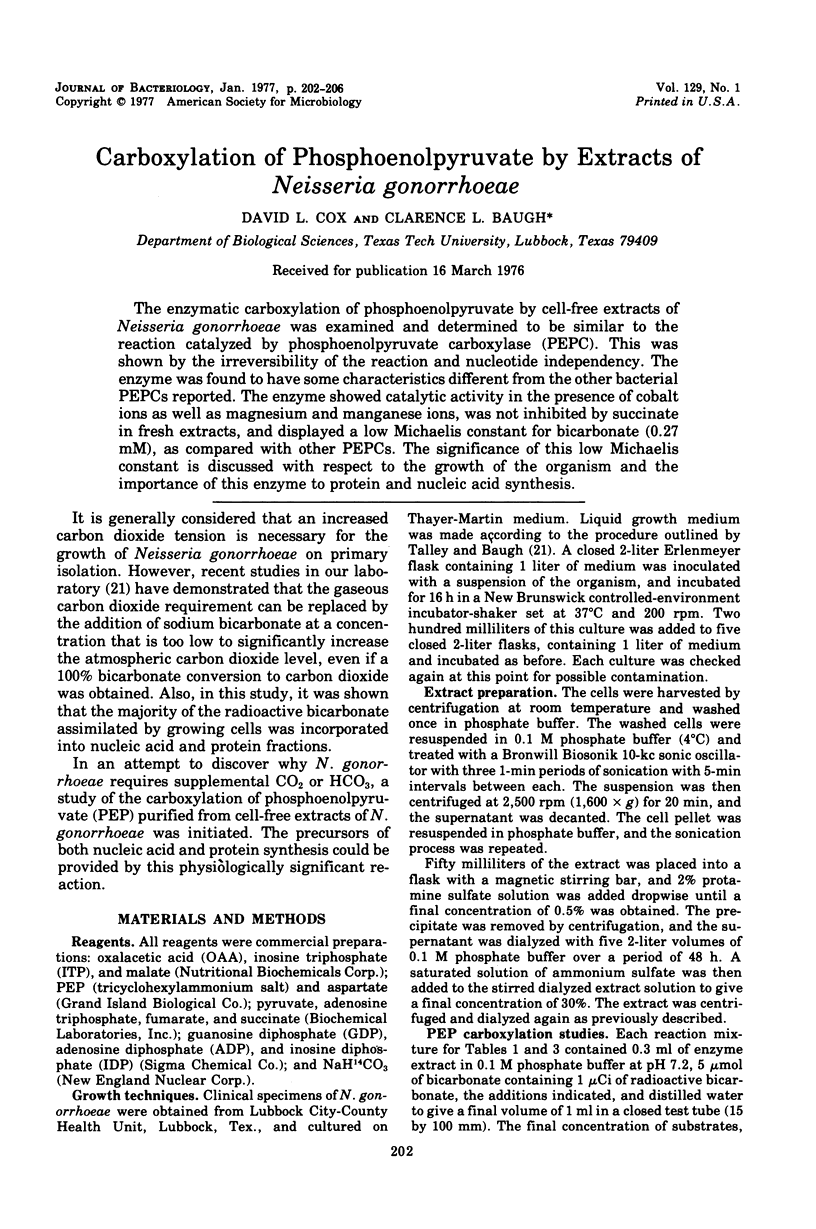
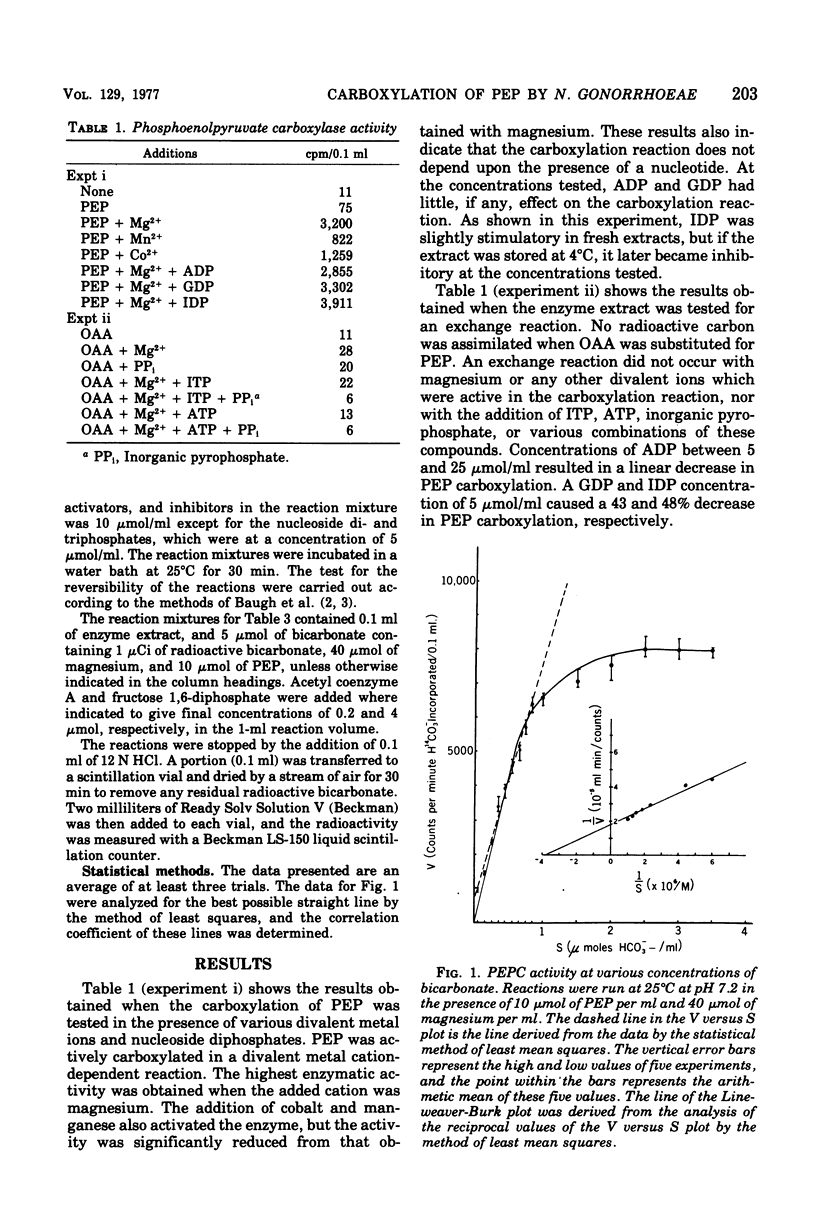
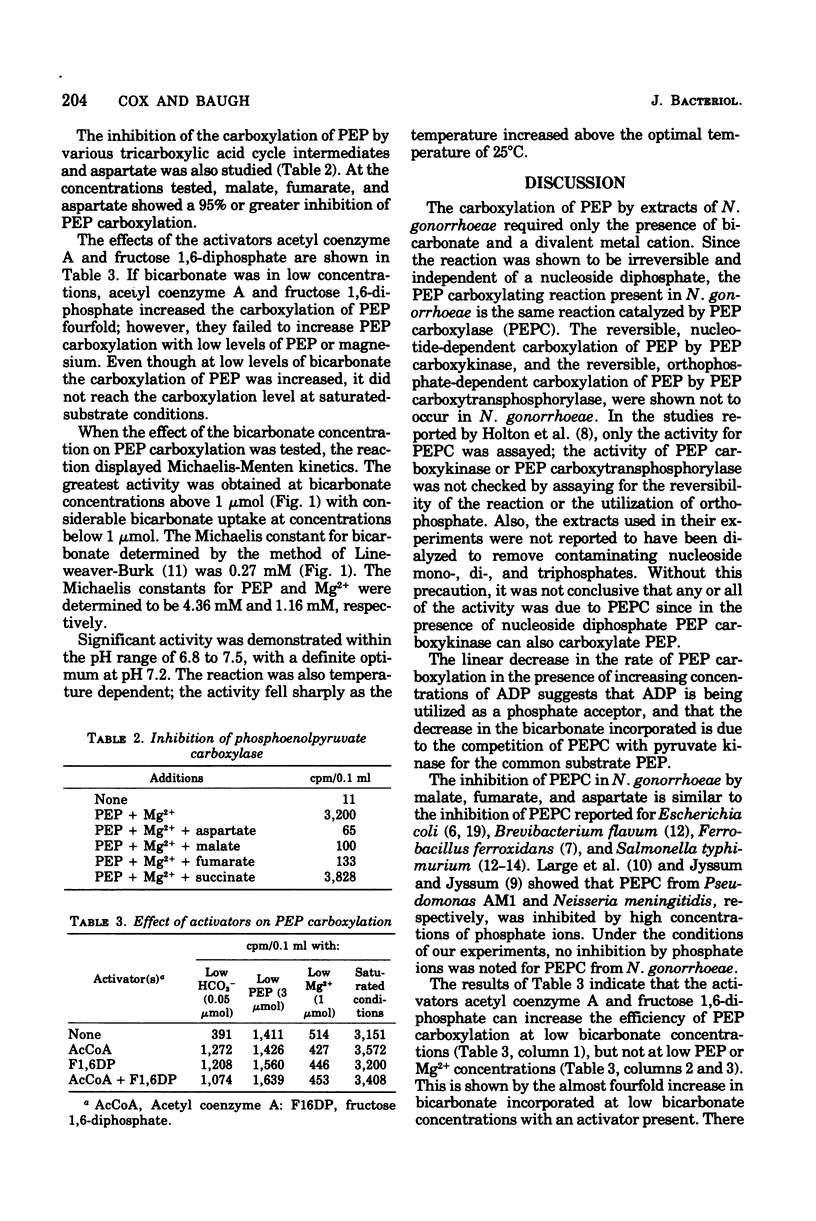
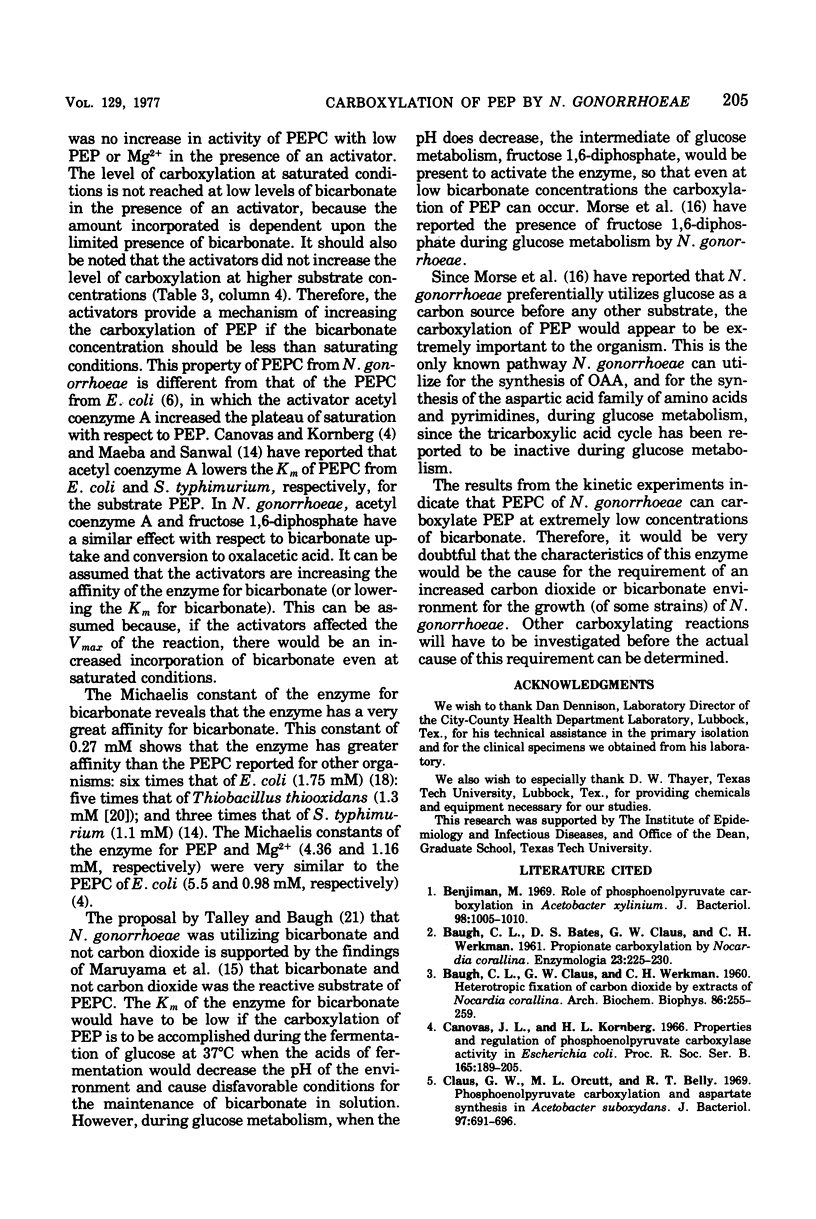
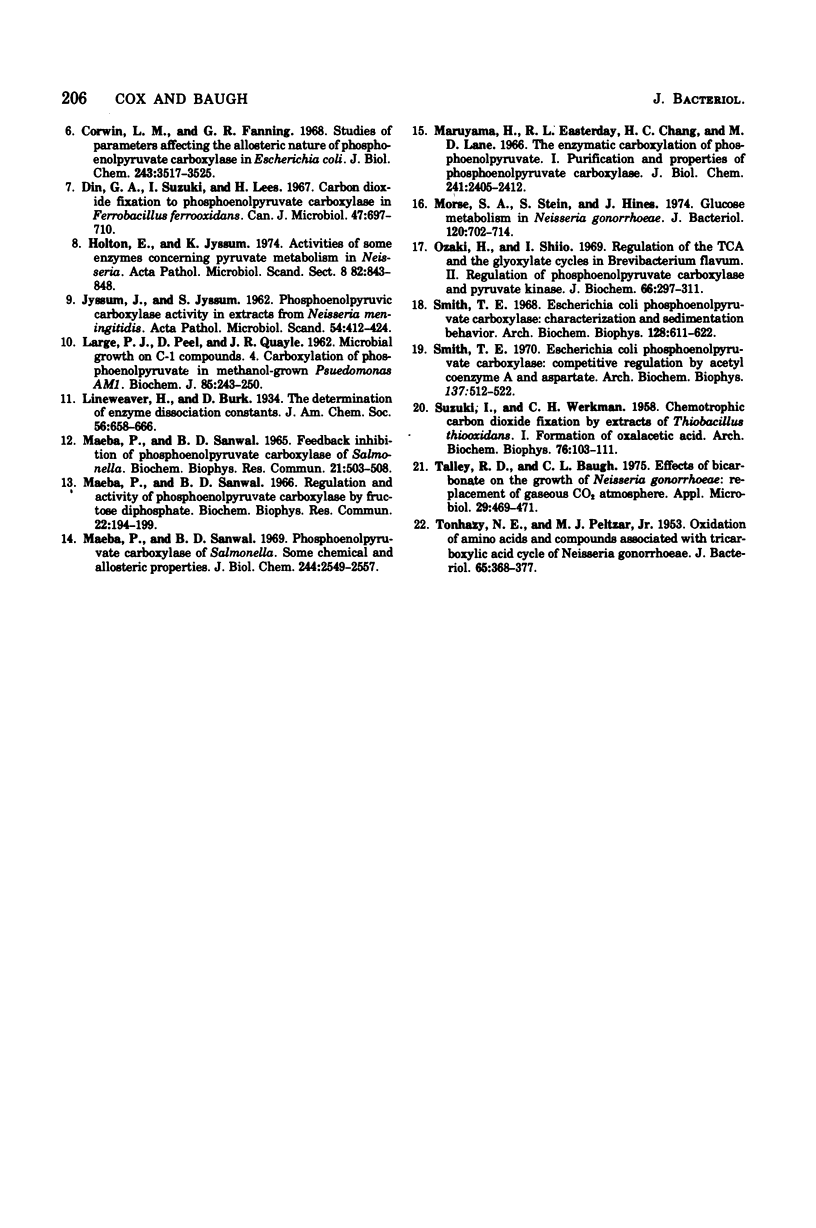
Selected References
These references are in PubMed. This may not be the complete list of references from this article.
- BAUGH C. L., BATES D. S., CLAUS G. W., WERKMAN C. H. Propionate carboxylation by Nocardia corallina. Enzymologia. 1961 Aug 15;23:225–230. [PubMed] [Google Scholar]
- BAUGH C. L., CLAUS G. W., WERKMAN C. H. Heterotrophic fixation of carbon dioxide by extracts of Nocardia corallina. Arch Biochem Biophys. 1960 Feb;86:255–259. doi: 10.1016/0003-9861(60)90414-8. [DOI] [PubMed] [Google Scholar]
- Benziman M. Role of phosphoenolpyruvate carboxylation in Acetobacter xylinum. J Bacteriol. 1969 Jun;98(3):1005–1010. doi: 10.1128/jb.98.3.1005-1010.1969. [DOI] [PMC free article] [PubMed] [Google Scholar]
- Claus G. W., Orcutt M. L., Belly R. T. Phosphoenolpyruvate carboxylation and aspartate synthesis in Acetobacter suboxydans. J Bacteriol. 1969 Feb;97(2):691–696. doi: 10.1128/jb.97.2.691-696.1969. [DOI] [PMC free article] [PubMed] [Google Scholar]
- Corwin L. M., Fanning G. R. Studies of parameters affecting the allosteric nature of phosphoenolpyruvate carboxylase of Escherichia coli. J Biol Chem. 1968 Jun 25;243(12):3517–3525. [PubMed] [Google Scholar]
- Cánovas J. L., Kornberg H. L. Properties and regulation of phosphopyruvate carboxylase activity in Escherichia coli. Proc R Soc Lond B Biol Sci. 1966 Aug 16;165(999):189–205. doi: 10.1098/rspb.1966.0064. [DOI] [PubMed] [Google Scholar]
- HALVERSON W. L., LONGSHORE W. A., Jr, PETERS R. F. The 1952 encephalitis outbreak in California. Public Health Rep. 1953 Apr;68(4):369–377. [PMC free article] [PubMed] [Google Scholar]
- Holten E., Jyssum K. Activities of some enzymes concerning pyruvate metabolism in Neisseria. Acta Pathol Microbiol Scand B Microbiol Immunol. 1974 Dec;82(6):843–848. doi: 10.1111/j.1699-0463.1974.tb02382.x. [DOI] [PubMed] [Google Scholar]
- Large P. J., Peel D., Quayle J. R. Microbial growth on C(1) compounds. 4. Carboxylation of phosphoenolpyruvate in methanol-grown Pseudomonas AM1. Biochem J. 1962 Oct;85(1):243–250. doi: 10.1042/bj0850243. [DOI] [PMC free article] [PubMed] [Google Scholar]
- Maeba P., Sanwal B. D. Feedback inhibition of phosphoenolpyruvate carboxylase of Salmonella. Biochem Biophys Res Commun. 1965 Dec 9;21(5):503–508. doi: 10.1016/0006-291x(65)90412-2. [DOI] [PubMed] [Google Scholar]
- Maeba P., Sanwal B. D. Phosphoenolpyruvate carboxylase of Salmonella. Some chemical and allosteric properties. J Biol Chem. 1969 May 25;244(10):2549–2557. [PubMed] [Google Scholar]
- Maruyama H., Easterday R. L., Chang H. C., Lane M. D. The enzymatic carboxylation of phosphoenolpyruvate. I. Purification and properties of phosphoenolpyruvate carboxylase. J Biol Chem. 1966 May 25;241(10):2405–2412. [PubMed] [Google Scholar]
- Morse S. A., Stein S., Hines J. Glucose metabolism in Neisseria gonorrhoeae. J Bacteriol. 1974 Nov;120(2):702–714. doi: 10.1128/jb.120.2.702-714.1974. [DOI] [PMC free article] [PubMed] [Google Scholar]
- Ozaki H., Shiio I. Regulation of the TCA and glyoxylate cycles in Brevibacterium flavum. II. Regulation of phosphoenolpyruvate carboxylase and pyruvate kinase. J Biochem. 1969 Sep;66(3):297–311. doi: 10.1093/oxfordjournals.jbchem.a129148. [DOI] [PubMed] [Google Scholar]
- SUZUKI I., WERKMAN C. H. Chemoautotrophic carbon dioxide fixation by extracts of Thiobacillus thiooxidans. I. Formation of oxalacetic acid. Arch Biochem Biophys. 1958 Jul;76(1):103–111. doi: 10.1016/0003-9861(58)90124-3. [DOI] [PubMed] [Google Scholar]
- Sanwal B. D., Maeba P. Regulation of the activity of phosphoenolypyruvate carboxylase by fructose diphosphate. Biochem Biophys Res Commun. 1966 Jan 24;22(2):194–199. doi: 10.1016/0006-291x(66)90431-1. [DOI] [PubMed] [Google Scholar]
- Smith T. E. Escherichia coli phosphoenolpyruvate carboxylase: characterization and sedimentation behavior. Arch Biochem Biophys. 1968 Dec;128(3):611–622. doi: 10.1016/0003-9861(68)90071-4. [DOI] [PubMed] [Google Scholar]
- Smith T. E. Escherichia coli phosphoenolpyruvate carboxylase: competitive regulation by acetyl-coenzyme A and aspartate. Arch Biochem Biophys. 1970 Apr;137(2):512–522. doi: 10.1016/0003-9861(70)90469-8. [DOI] [PubMed] [Google Scholar]
- Talley R. S., Baugh C. L. Effects of bicarbonate on growth of Neisseria gonorrhoeae: replacement of gaseous CO2 atmosphere. Appl Microbiol. 1975 Apr;29(4):469–471. doi: 10.1128/am.29.4.469-471.1975. [DOI] [PMC free article] [PubMed] [Google Scholar]


